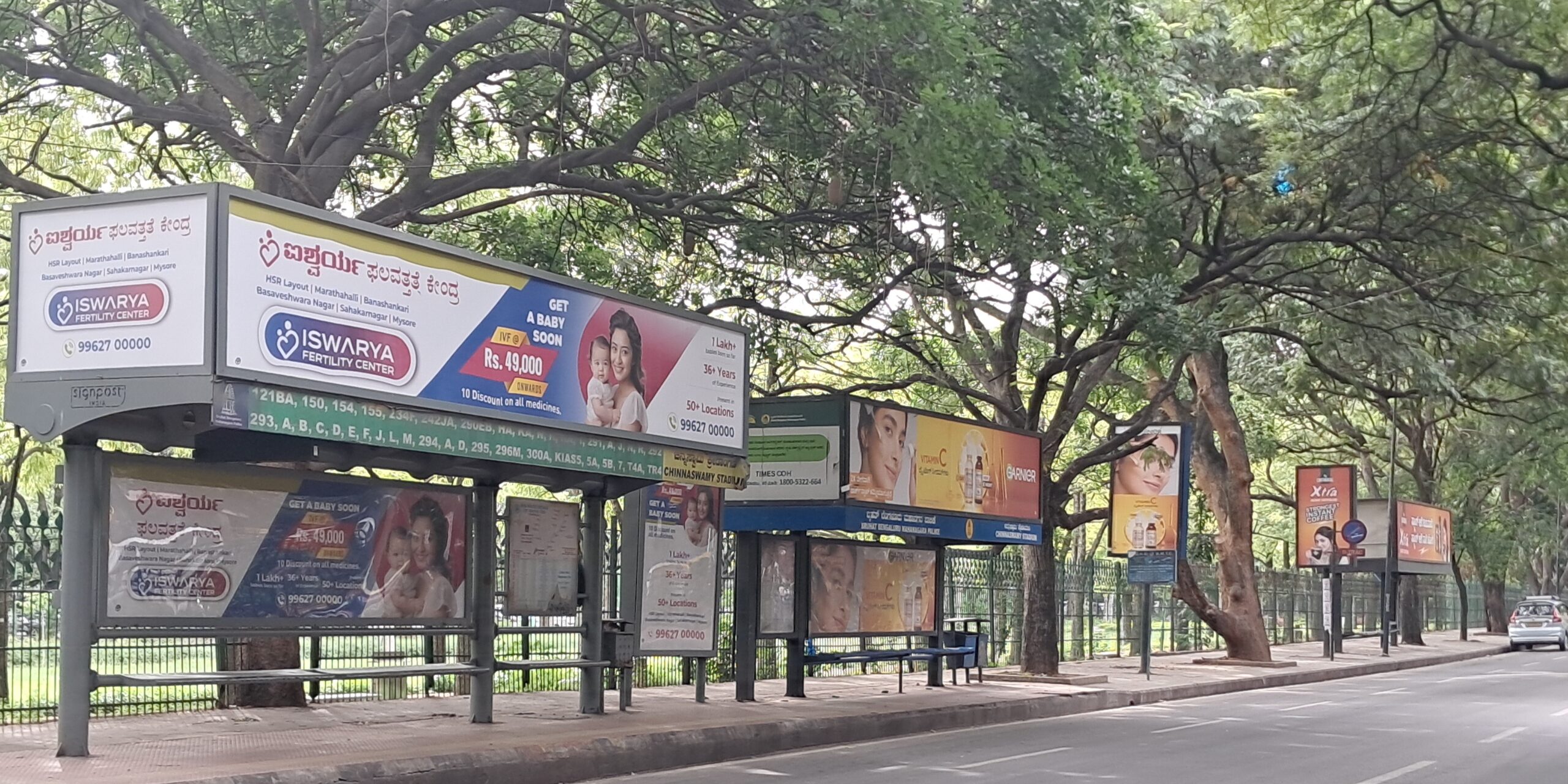Proposed bylaws overturn the ban on advertising by private agencies, allowing them to advertise subject to location, safety and content.
Published Aug 20, 2024 | 8:00 AM ⚊ Updated Aug 20, 2024 | 8:00 AM

Multiple bus shelters on Queens Road with advertisement hoardings. (Sneha Priya Yanappa)
The Bruhat Bengaluru Mahanagara Palike (BBMP) has recently released a draft advertisement bylaws, seeking comments from the public.
The proposed bylaws overturn the previous ban on advertising by private agencies, allowing them to advertise, subject to location, safety, and content restrictions.
The draft bylaws moot the public-private-partnership (PPP) model for outdoor advertisement. PPP in outdoor advertisements involves developing and maintaining urban infrastructure by private entities in exchange for advertising rights on such infrastructure with concessions on advertising fees.
PPPs in Bengaluru are a result of the Bangalore Agenda Task Force (BATF) initiative conceived by the Karnataka government in 1999.
Trends suggest that most PPP models in advertising have involved advertising-funded installation and maintenance of ‘street furniture’ such as bus shelters, benches, and public toilets.
However, these partnerships bring with them several concerns — poor management of the project by the private entity, inappropriate business models, and vested interests antithetical to the intent and purpose behind the projects.
The proposed bylaws provide for regulations in case of advertisements on public infrastructure, legacy advertisements, and existing PPPs. It allows for the right to display advertisements on public infrastructure to a licensed or registered advertiser by a public auction process, including through a PPP model.
Public infrastructure under the bylaws includes various assets such as bus shelters, skywalks, public toilets, traffic police chowkis, and others.
The proposed bylaws also state that in determining the concession period, the cost of infrastructure, maintenance, expected revenue returns and the period of concession shall be taken into consideration.
The PPP model for outdoor advertising in Bengaluru is often adopted for small and low-cost urban assets. The private entity which develops such an asset makes significantly more revenue from advertising on the asset, than it spends on developing it.
This may happen due to an extended period of advertising rights given by BBMP, during which such private entities are exempt from paying advertising fees to the corporation.
The concession periods currently are long, going up to 30 years, thereby preventing BBMP from capitalising on the revenue made by the private entity for that period.
Often, advertisers approach the BBMP requesting permits to develop structures based on the visibility of the structure and advertisement revenue that they will recover from it as opposed to the benefit that the asset will create for the city.
This has led to the development of superfluous structures across the city as per the whims of outdoor advertisers. One can notice seven immaculate bus shelters within a span of 100m on Queens Road in Central Bengaluru while residents continue to complain about badly maintained bus shelters in those parts of the city with lesser eyeballs on bus shelter hoardings.
Monitoring advertising by private entities under the PPP model has proven onerous for BBMP, allowing leeway for such entities to advertise in a haphazard and uncontrolled manner around the developed asset.
Going forward, the bylaws must prescribe a capital limit below which the PPP model should not be adopted by BBMP. This is required to incentivize the corporation to develop and manage low-cost infrastructure and generate revenue through providing advertisements on the same, while only high-cost infrastructures are reserved for PPP.
Engaging in PPP for small urban assets will not only lead to revenue losses for the corporation but also cause uncontrolled mushrooming of advertising across the city.
BBMP must be empowered to test the quality of the structure developed through PPP prior to granting concession on advertisements, and mechanisms must be put in place to ensure that private entities are responsible for maintaining the structure and surrounding areas, during the concession period.
The contracts adopted with private entities must also be publicly available to ensure transparency and accountability. PPP contracts must permit the corporation to make such adjustments to public infrastructure, which may be identified to be beneficial in the future.
For instance, the BBMP sought to make bus shelters commuter-friendly by providing bus numbers and timings on LED screens under the Nirbhaya fund.
However, several advertising agencies that had developed bus shelters refused to include LED screens citing electricity costs, making over 200 shelters lack this service.
In order to ensure balanced development through PPP, the bylaws must mandate that a feasibility study must be conducted by BBMP prior to sanctioning a PPP advertising project.
The feasibility study must assess aspects such as demand for the infrastructure and environmental impact, apart from revenue collection, prior to the adoption of PPP for any infrastructure.
PPP as a model may be extremely beneficial for the city or exploitative of the corporation, purely based on its implementation.
The devil is in the details, and BBMP has a chance to put in place stringent measures to prevent over-advertising, revenue leakages and unscrupulous practices.
Revenue generation for the corporation is only one aspect of outdoor advertising. Public benefit and planned development must not be overlooked.
(Views expressed are those of the authors. Edited by Muhammed Fazil)
(South First is now on WhatsApp and Telegram)
